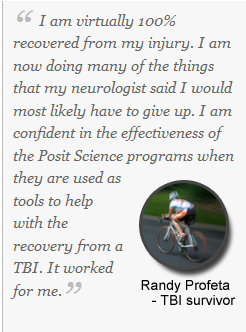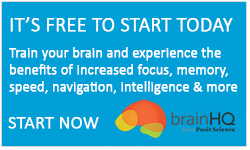Traumatic Brain Injury and BrainHQ
The symptoms that individuals with traumatic brain injuries suffer from range from memory loss, social behavioural problems, issues with processing speed, as well as hearing and vision loss. The brain training exercises in BrainHQ have been designed to specifically target areas and functions of the brain that are affected in people who suffer from traumatic brain injuries. As a result, many TBI sufferers who have used our brain training programs have experienced cognitive improvements in these areas.
Moreover, the Department of Defense awarded $2 million to Brain Plasticity, Inc. in light of the promising results that our brain training has achieved with TBI sufferers to help fund further research on the subject using BrainHQ. Posit Science has made its effective brain training programs available to the thousands of veterans who suffer from traumatic brain injuries at top military support centres such as Easter Seals and the Walter Reed Hospital.
Background on TBI
Traumatic brain injuries occur when the head is hit suddenly and violently. Typically TBIs are the result of a fall, accident in a vehicle, injury from sports activities, or wartime injuries in combat. As reported by the Centers for Disease Control and Prevention in the U.S., nearly 2 million Americans are affected by traumatic brain injuries every year and millions of others in Canada and around the world. These injuries can cause some severe damage such as bruising in the brain, tearing nerve fibres, and bleeding within the skull. Traumatic brain injuries can affect an individual in many ways and not all injuries result in the same affects. TBI sufferers can experience symptoms ranging from memory loss, depression, and anxiety to behavioural and physical issues.
According to traumatic brain injury statistics, hospitalization and death stemming from TBIs is highest among the elderly demographics – particularly individuals who are 75 years or older in age. Interestingly, the number of males in this category is much higher than females. Another high risk demographic is soldiers and military personnel.
While a full recovery is possible in some cases, there is no single “cure” for traumatic brain injuries. The main objective with rehabilitation and brain training is to help TBI sufferers recover as much cognitive function as possible given their specific injury.
The Story of Ryan’s Traumatic Brain Injury
Ryan Reitmeyer was 29 years old when he had parts of his brain removed following a boating accident. Even though doctors said he would never be able to take care of himself again he made a remarkable recovery and is even driving, boating, and says he feels “on top of the world”. Ryan was able to regain his concentration and memory with Posit Science’s brain training exercises and his family credit BrainHQ for his speedy rehabilitation. As Ryan’s dad says, “We, as a family, needed Ryan back… and we got Ryan back. We appreciate all the help we got, from everyone- but especially Posit Science.”






 English
English
 Français
Français


